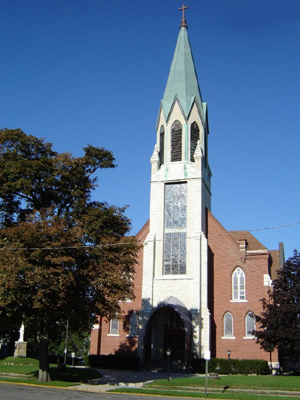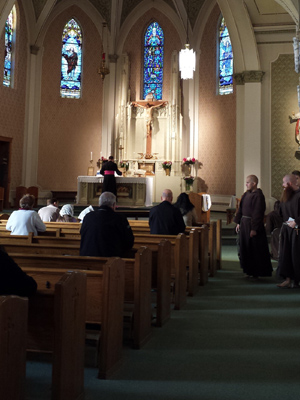| |
 |
 |
 |
| Comment on this report, or find other reports. |
 |
| Our Mystery Worshippers are volunteers who warm church pews for us around the world. If you'd like to become a Mystery Worshipper, start here. |
 |
| Find out how to reproduce this report in your church magazine or website. |
|
|
| 2948: St Stanislaus, South Bend, Indiana, USA |
 |
 |
 |
Mystery Worshipper: William Dewy.
The church: St Stanislaus, South Bend, Indiana, USA.
Denomination: Roman Catholic. The parish has been entrusted to the Priestly Fraternity of St Peter by the Bishop of Fort Wayne-South Bend. The Priestly Fraternity of St Peter was established in 1988 by Pope John Paul II as a Clerical Society of Apostolic Life of Pontifical Right. On its website the Fraternity lists among its purposes "forming and leading stable parishes and communities that help reunite those who prefer and often have a deep affection for the more reverent and traditional liturgical forms who may have been alienated by abuse and dissent that has predominated in our times."
The building: The building is an American Gothic structure designed at the end of the 19th century and looks lovingly tended for its century. The exterior is mostly brick with a central tower and steeple with a white stone façade at the main door. The interior has a spacious feel with patterned walls and several large and colorful statues. Happily, the interior doesn’t look like it was cobbled up to be “modernized” by a committee who didn’t like the original architect (or other committee members).
The church: As a FSSP parish, there is celebration of the traditional Latin mass. They also advertise themselves as a “personal parish,” apparently meaning that the people assembled into a parish are not there for geographic or ethnic reasons, but by personal selection. Historically, St Stanislaus is one of several Polish parishes in the city of South Bend. Evidence of their ethnic pride includes a fund raiser offering pierogi (savory meat dumplings) from a local restaurant and advertisement for a Polish dinner hosted by another parish in nearby Michigan City, Indiana.
The neighborhood: South Bend is a city in northern Indiana just south of the University of Notre Dame, which is independent of the city. Once home to the Studebaker Automobile Company, later known as Studebaker-Packard Corporation, as well as other heavy industry such as Bendix, Honeywell and Allied Signal, the city fell on hard times when Studebaker ceased production in 1963 and other industries moved away. But things are looking up nowadays as the old manufacturing facilities are being retooled and redeveloped to attract 21st century businesses. St Stanislaus is in a residential neighborhood on the west side of South Bend. The neighborhood was once known as the Golden Hills.
The cast: The Revd Msgr John C. Fritz, FSSP, pastor.
The date & time: Feast of All Saints, Sunday, November 1, 2015, 10.00am.
What was the name of the service?
Sung Mass.
How full was the building?
Perhaps 200 were present, not too tightly packed but spread out.
Did anyone welcome you personally?
A mother with small children smiled at me as she held the door open for me when I followed her family into the church.
Was your pew comfortable?
The pew was quite comfortable. So was the kneeler.
How would you describe the pre-service
atmosphere?
The faithful were saying the Rosary (in English) when I entered. There were a great many young families, and some older couples and individuals. There was that buzz of children’s babble sound, but it made the place sound open for business. There were several barefoot Franciscan brothers in brown habits. It was a little busy – noisy while still being reverent.
What were the exact opening words of the
service?
The opening (and only) hymn of the people was “Immaculate Mary” (Lourdes Hymn). The service started with “Asperges me, Domine, hyssopo” ("You will sprinkle me, O Lord, with hyssop").
What books did the congregation use during the
service?
There was a service book with some hymns in the pews, but nobody touched it. Several people brought their own Latin missals to which they referred.
What musical instruments were played?
A pipe organ, very nicely played in the west gallery. I regret that I do not know the names of the organist, the cantor(s) or other members of the schola cantorum, but they were excellent and added much to the beauty of the mass.
Did anything distract you?
The children were generally well behaved, but there were a lot of them and a lot of kinetic and juvenile murmuring. I wouldn’t have wished the children away, but I wish I had sat closer to the front.

Was the worship stiff-upper-lip, happy clappy, or
what?
The worship was stiff without being rigid. It was certainly well planned and executed.
I observed the people were better dressed than the average religious flock. The bulletin states: "We encourage all to wear decorous
attire befitting the sacred place and divine worship" and goes on to specify exactly what that might mean, including eschewing "raffish clothing." It ended with the question, “How did your babcia [Polish for grandmother] dress for church? What would she say now?”
Exactly how long was the sermon?
25 minutes, but close to 10 minutes of that was some announcements and the re-reading of the lessons in English for the edification of the people.
On a scale of 1-10, how good was the preacher?
10 – Seldom do I recall anybody preaching with such alacrity. Throughout his talk, the preacher bragged on Jesus, the church, the bishop and the parish. Somehow, he was a cheerleader without being cheesy or condescending.
In a nutshell, what was the sermon
about?
Father preached on the St Matthew Beatitudes. Never fear doing good. External decency is worthy of attainment. Somehow he slipped in a joke about Anglicans beings saved by taste alone. But virtue on the inside is or approaches the Christian ideal.
Which part of the service was like being in
heaven?
The schola singing the minor propers and the precision of the altar servers.
And which part was like being in... er... the other place?
Aside from most everything being in Latin, I could understand very little being said. The big space of the church with no discernable microphones apart from the pulpit made for a mushy sound. Being rather far back in the church amid the fertile families, I felt disenfranchised from the whole service.
What happened when you hung around after the service looking lost?
Not much. People stayed in church to pray, or went on the All Saints party (see below), or gathered up their children and their accouterments.
How would you describe the after-service
coffee?
The assembly was invited to a party in the church basement for all the Saints.
Children were dressed as their patron saints. I regret that I was not able to attend such a fete. Ninety-five minutes of church was more time than I allotted myself, and I had other plans to keep.
How would you feel about making this church your regular (where 10 = ecstatic, 0 = terminal)?
9 – I would love to be here often; I knew I was in a liturgy mindful of the beauty of holiness to the greater glory of God and not some business meeting of Christians.
Did the service make you feel glad to be a
Christian?
Oh, yes.
What one thing will you remember about all this in seven days' time?
What would your babcia say now? |
|
|
 |
 |
 |
| We rely on voluntary donations to stay online. If you're a regular visitor to Ship of Fools, please consider supporting us. |
 |
 |
 |
| The Mystery Pilgrim |
 |
| One of our most seasoned reporters makes the Camino pilgrimage to Santiago de Compostela in Spain. Read here. |
 |
 |
 |
| London churches |
 |
| Read reports from 70 London churches, visited by a small army of Mystery Worshippers on one single Sunday. Read here. |
| |
|
|
|
|


